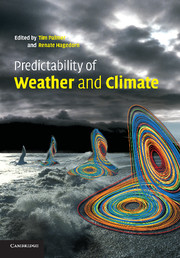Book contents
- Frontmatter
- Contents
- List of contributors
- Preface
- Chapter 1 Predictability of weather and climate: from theory to practice
- Chapter 2 Predictability from a dynamical meteorological perspective
- Chapter 3 Predictability – a problem partly solved
- Chapter 4 The Liouville equation and atmospheric predictability
- Chapter 5 Application of generalised stability theory to deterministic and statistical prediction
- Chapter 6 Ensemble-based atmospheric data assimilation
- Chapter 7 Ensemble forecasting and data assimilation: two problems with the same solution?
- Chapter 8 Approximating optimal state estimation
- Chapter 9 Predictability past, predictability present
- Chapter 10 Predictability of coupled processes
- Chapter 11 Predictability of tropical intraseasonal variability
- Chapter 12 Predictability of seasonal climate variations: a pedagogical review
- Chapter 13 Predictability of the North Atlantic thermohaline circulation
- Chapter 14 On the predictability of flow-regime properties on interannual to interdecadal timescales
- Chapter 15 Model error in weather and climate forecasting
- Chapter 16 Observations, assimilation and the improvement of global weather prediction – some results from operational forecasting and ERA-40
- Chapter 17 The ECMWF Ensemble Prediction System
- Chapter 18 Limited-area ensemble forecasting: the COSMO-LEPS system
- Chapter 19 Operational seasonal prediction
- Chapter 20 Weather and seasonal climate forecasts using the superensemble approach
- Chapter 21 Predictability and targeted observations
- Chapter 22 The attributes of forecast systems: a general framework for the evaluation and calibration of weather forecasts
- Chapter 23 Predictability from a forecast provider's perspective
- Chapter 24 Ensemble forecasts: can they provide useful early warnings?
- Chapter 25 Predictability and economic value
- Chapter 26 A three-tier overlapping prediction scheme: tools for strategic and tactical decisions in the developing world
- Chapter 27 DEMETER and the application of seasonal forecasts
- Index
- Plate section
- References
Chapter 11 - Predictability of tropical intraseasonal variability
Published online by Cambridge University Press: 03 December 2009
- Frontmatter
- Contents
- List of contributors
- Preface
- Chapter 1 Predictability of weather and climate: from theory to practice
- Chapter 2 Predictability from a dynamical meteorological perspective
- Chapter 3 Predictability – a problem partly solved
- Chapter 4 The Liouville equation and atmospheric predictability
- Chapter 5 Application of generalised stability theory to deterministic and statistical prediction
- Chapter 6 Ensemble-based atmospheric data assimilation
- Chapter 7 Ensemble forecasting and data assimilation: two problems with the same solution?
- Chapter 8 Approximating optimal state estimation
- Chapter 9 Predictability past, predictability present
- Chapter 10 Predictability of coupled processes
- Chapter 11 Predictability of tropical intraseasonal variability
- Chapter 12 Predictability of seasonal climate variations: a pedagogical review
- Chapter 13 Predictability of the North Atlantic thermohaline circulation
- Chapter 14 On the predictability of flow-regime properties on interannual to interdecadal timescales
- Chapter 15 Model error in weather and climate forecasting
- Chapter 16 Observations, assimilation and the improvement of global weather prediction – some results from operational forecasting and ERA-40
- Chapter 17 The ECMWF Ensemble Prediction System
- Chapter 18 Limited-area ensemble forecasting: the COSMO-LEPS system
- Chapter 19 Operational seasonal prediction
- Chapter 20 Weather and seasonal climate forecasts using the superensemble approach
- Chapter 21 Predictability and targeted observations
- Chapter 22 The attributes of forecast systems: a general framework for the evaluation and calibration of weather forecasts
- Chapter 23 Predictability from a forecast provider's perspective
- Chapter 24 Ensemble forecasts: can they provide useful early warnings?
- Chapter 25 Predictability and economic value
- Chapter 26 A three-tier overlapping prediction scheme: tools for strategic and tactical decisions in the developing world
- Chapter 27 DEMETER and the application of seasonal forecasts
- Index
- Plate section
- References
Summary
Introduction
Not long after the development of numerical weather forecasting in the 1950s, predictability studies emerged with the desire to determine the theoretical limits associated with deterministic weather forecasting (e.g. Thompson, 1957; Lorenz, 1965, 1982; this volume; Palmer, this volume). Estimating these limits helped to better quantify the capabilities and skill level of operational weather forecast models and to determine how far and fast the community should press the embryonic field of numerical weather forecasting. Numerical predictability studies expanded to include the ocean and the climate scale with the advent of seasonal-to-interannual forecasting based on the El Niño–Southern Oscillation (ENSO) (e.g. Cane et al., 1986; Graham and Barnett, 1995; Kirtman et al., 1997; Barnston et al., 1999; Anderson, this volume; Hagedorn et al., this volume; Shukla and Kinter, this volume). In this case, it was of interest to understand the theoretical limits for predicting tropical Pacific Ocean sea surface temperature (SST) anomalies, and then in turn their implications for predicting monthly or seasonal anomalies of midlatitude circulation, temperature and rainfall.
Very recently, predictability at the intraseasonal timescale (i.e. lead times of about 2 weeks to 2 months) has garnered great interest (Schubert et al., 2002; Waliser et al., 2003a; ECMWF, 2004). This evolution of research and operations in regard to specific prediction regimes (i.e. weather, seasonal and then intraseasonal) has mimicked quite remarkably that anticipated by John von Neumann (1955; relevant excerpt can be found in Waliser, 2005).
Information
- Type
- Chapter
- Information
- Predictability of Weather and Climate , pp. 275 - 305Publisher: Cambridge University PressPrint publication year: 2006
References
Accessibility standard: Unknown
- 23
- Cited by
